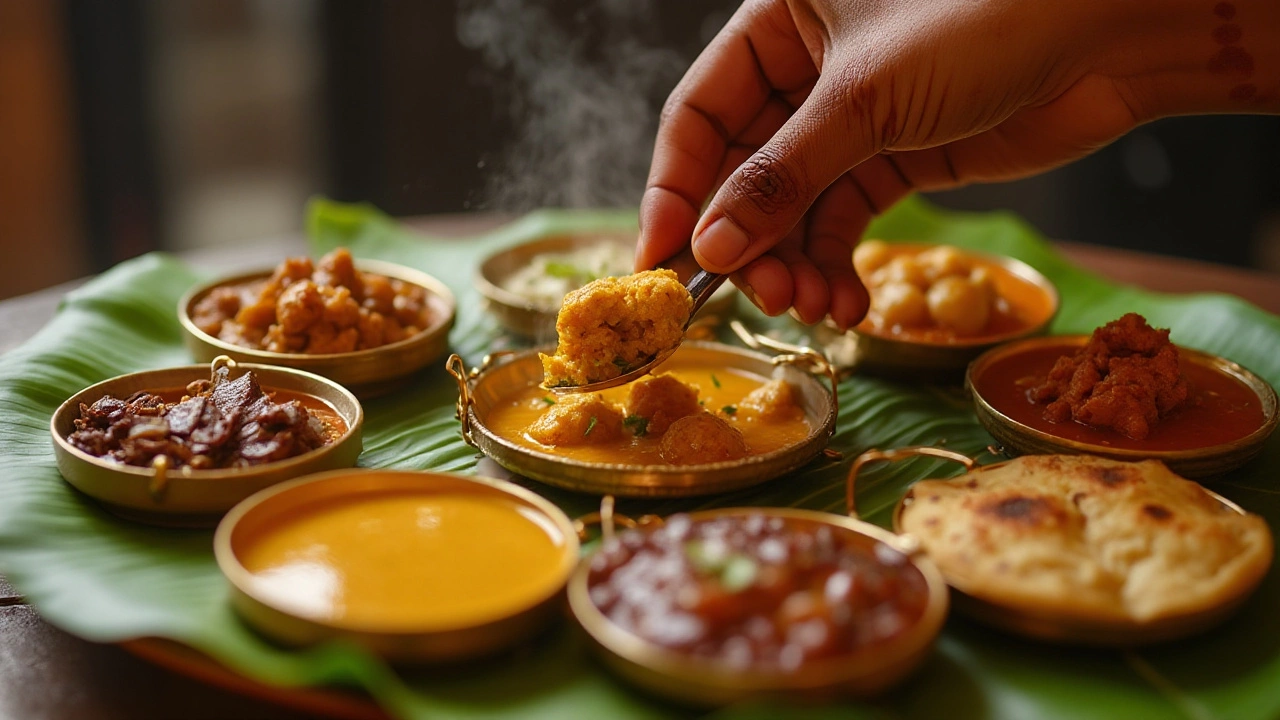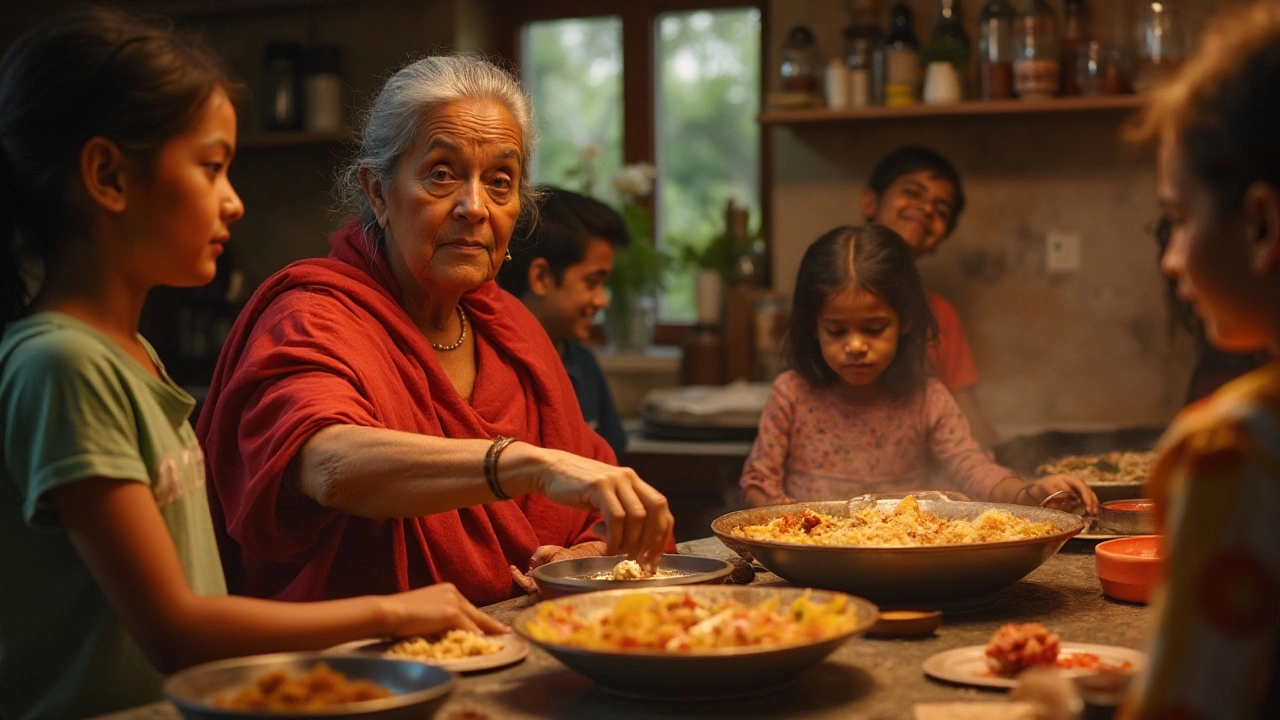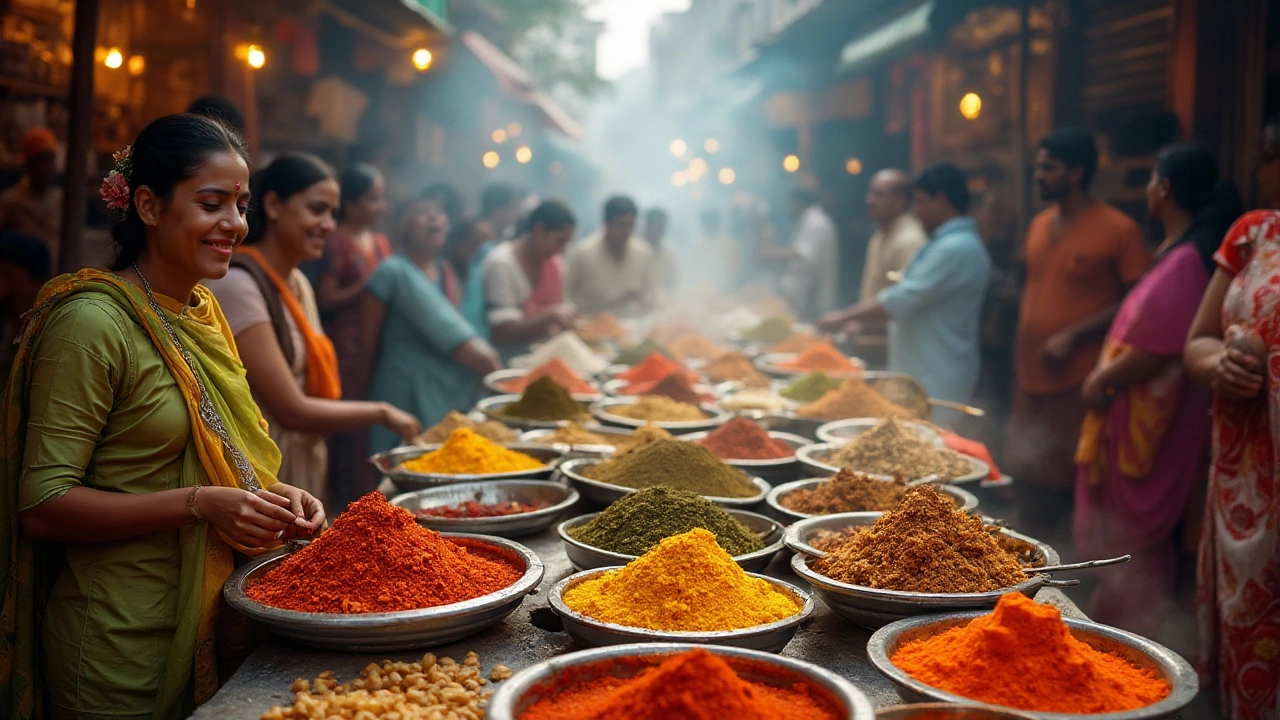India's culinary landscape is as diverse as its culture, offering a tantalizing array of dishes that reflect the subcontinent's varied heritage. For anyone enamored by the flavors of India or planning a visit, a common question arises — what do Indians eat the most? The answer to this is as layered as the country's history itself.
Indian meals primarily center around simple staples like rice and wheat, often accompanied by an array of curries and vegetables. These staples form the basis of daily eating habits across the country, each adding their unique flavor and regional twist. Understanding these fundamentals is your first step to embarking on a delicious cultural journey through India.
- Understanding the Indian Culinary Palette
- The Ubiquitous Curry: A Staple on Every Plate
- Rice and Rotis: The Heart of Indian Meals
- Regional Varieties That Define Flavor
- The Cultural Significance of Eating Together
- Tips for Enjoying Indian Food During Your Visit
Understanding the Indian Culinary Palette
India's culinary tradition is a confluence of thousands of years of cultural exchange, geographic diversity, and evolving tastes. From the rugged terrains of the Himalayas to the lush backwaters of Kerala, the Indian cuisine offers a kaleidoscope of flavors that appeals to the adventurous palate. At the heart of Indian cooking is a remarkable ability to blend diverse ingredients and spices, creating dishes that have layers of taste and complexity. Whether it's the robust warmth of garam masala or the tangy punch of tamarind, each flavor note plays its part in this symphony.
India's vast landscape is divided into regional cuisines, each with distinct characteristics borne out of historical influences and local produce. The cultural tourism India scene thrives on introducing visitors to these culinary contrasts. For example, Northern dishes are known for their rich gravies, courtesy of cool climates necessitating heartier meals. Staples like wheat are prevalent here, often transformed into breads such as roti and naan, served with delectable curries. Meanwhile, Southern styles prefer rice as a base, accompanying it with sambar or flavored with coconut and tamarind.
Let's not forget the incredible plant-based repertoire that dominates Indian household kitchens. Since ancient times, many Indians have adhered to vegetarianism, motivated by religious beliefs and philosophical doctrines. Dals, paneer, and an array of vegetables cooked in myriad ways are central to the diet, ensuring a balance of flavors, nutrients, and satisfaction. Speaking on the richness of Indian food, renowned chef and restaurateur Madhur Jaffrey once said, "Indian cuisine is as varied as the country itself, with every state having its own specialties, all imbued with a unique identity."
From exploring the bustling spice markets to enjoying home-cooked meals with locals, every bit offers a dynamic experience in understanding India through its food.
The notion of spices, ubiquitous in Indian dishes, deserves individual attention. Spices are not merely reserved for creating heat; they bring aroma, color, and subtlety to the dish, transforming simple ingredients into a feast for the senses. Throughout history, explorers and traders were drawn to India for these very treasures, red chillies from the Americas found their place in Indian cuisine, and the rest of the world discovered black pepper, often referred to as 'black gold'.
In essence, the popular Indian food scene is an ever-evolving dialogue between tradition and modernity. This delicate balance ensures preservation of age-old recipes while simultaneously embracing contemporary tastes. As global influences ripple through India's cities, international cuisines are increasingly present, but they coexist harmoniously with time-honored traditions. This constant reinvention keeps the culinary scene vibrant, making India a sought-after destination for food enthusiasts looking to explore with all their senses. When you visit, be open to trying the unexpected and savor the complexity that each mouthful offers.
The Ubiquitous Curry: A Staple on Every Plate
In India, the word "curry" evokes more than just a dish; it symbolizes a profound culinary tradition that embodies the essence of Indian cuisine. Although in international terms, a curry can mean anything with a saucy consistency, in India, it takes numerous forms, colors, and flavors. The variety of ingredients and cooking techniques used in curry preparation extends an invitation to explore and delight in the depths of regional cuisines across the vast subcontinent. Curries may be thick or thin, spicy or mild, vegetarian or laden with meats such as chicken, lamb, or seafood. These dishes are usually paired with staples like rice or bread, making it an adaptable and integral part of everyday meals.
The secret behind the intense flavors lies in the blend of spices, often referred to as a "masala." This blend can include cumin, coriander, turmeric, and chili powder, together with a mix of local spices that vary from one region to another. In South India, for instance, sambar—a tangy, spicy lentil curry—often graces the dining table, capturing the tropical essence with coconut and tamarind. On the other hand, North India's butter chicken, with its rich, creamy, tomato-based sauce, tells a different story of taste and texture. Across the landscape of Indian cuisine, curries have a way of bringing warmth to the table, serving as a reminder of family gatherings and the comfort of home-cooked meals.
"Curry is not one thing, it is a prism of flavors, a reflection of India's culinary diversity," chefs often remind aspiring cooks, a testament to the dish's almost infinite variability and cultural value.
From bustling street vendors to elegant dining establishments, you'll find curries playing a starring role throughout India. Many regional specialties have made their way into homes and restaurants nationwide, each carrying unique influences. For example, Bengal's fish curry, rich with mustard and served with steamed rice, showcases the region's love for seafood. Meanwhile, in Maharashtra, kitchens often produce a fiery dish known as 'Kolhapuri curry,' with chilies that could bring tears to an unsuspecting eye. Such is the dynamism of curries; they adapt to incorporate local produce and community tastes, evolving with time and geography.
So, whether you're a culinary adventurer or a food-loving tourist, indulging in a variety of curries during your Indian journey is an experience almost akin to tasting the country's heritage. A peek into any Indian home during meal time reveals a colorful spread of curries, signaling warmth, hospitality, and an embrace of traditional spirit. As you savor each bite, let the spices guide you through stories woven into the daily life of this diverse nation, where every curry unfolds a narrative of its own.

Rice and Rotis: The Heart of Indian Meals
At the very core of Indian meals are two seemingly humble staples: rice and rotis. These are not merely dietary necessities but are deeply woven into the tapestry of Indian life, each telling its own tale of agricultural heritage and culinary ingenuity. The prominence of rice is particularly noteworthy, given its historical roots in the rain-fed regions of Eastern India, significantly influencing the region's eating habits. Rice's simple versatility introduces a comforting base against which rich, spicy curries can play, whether simmered with delicate spices or transformed into exotic biryanis. Speaking of biryani, each state’s variation is a symphony of flavor and a testament to local tastes. Andhra rice juxtaposes tamarind's tang with chili's warmth, while Bengal's sweet balance enriches fish-based meals.
Rotis and its variations, on the other hand, predominantly claim their territory in the North. Woven through stories of wheat cultivation in Punjab and Haryana, these soft flatbreads are the soulmates of every dhaba-style meal. Being more than just a repository for scooping curries, rotis reflect an artful expression of texture and technique, often hand-rolled meticulously and puffed till perfection. Whether enjoyed as a butter-layered paratha or a universally loved naan, rotis illustrate the innovative spirit of Indian cuisine without losing their authentic simplicity. Renowned chef Sanjeev Kapoor once said, "The Indian bread basket is as diverse as the Indian spice box - always surprising and deeply satisfying."
Sanjeev Kapoor: "The Indian bread basket is as diverse as the Indian spice box - always surprising and deeply satisfying."
India’s culinary mosaic doesn’t stop at rice and rotis. The marriage of these staples with lentils, known locally as 'daal,' creates unpretentious magic. Lentils dish up a nutritional powerhouse, offsetting grains with protein and minerals pivotal for countless Indian families. Amidst all this, a lesser-known fact elicits astonishment - India is one of the largest producers of rice globally, yet it holds rice in profound respect, often used in rituals as a symbol of fertility and abundance. Rotis too, have cultural symbolism, sharing space at the family table where food is a celebration of bonds, not just appetite quenching. This shared cultural significance ties seamlessly into the great dining ritual of “thaali,” a distinct Indian dining experience offering an opulent spread, making sure that both rice and rotis find a pedestal on an authentically Indian platter.
Regional Varieties That Define Flavor
India's vast geographical landscape offers a tapestry of flavors that vary dramatically from one region to another. This culinary diversity is both a reflection of the country's rich history and its unique cultural tapestry. From the spicy curries of Kerala to the delicate flavors of Goa, each region boasts a distinctive palette that sets it apart. In the north, the use of dairy products like ghee and paneer is prevalent, while in the south, coconut and tamarind take the spotlight in many dishes. These differing ingredients mirror the local produce available, making each dish a tribute to the land on which it was created.
Traveling east to west, you will find that no two states offer the same kind of meal. The east, particularly Bengal, is known for its sweet palate, with dishes like 'roshogolla' winning hearts around the globe. Contrast this with the western state of Gujarat, where meals are typically vegetarian due to cultural traditions and highlight a perfect balance of sweet and savory within a single plate. Influences of outside cultures are evident, exemplified by how Maharashtra's dishes reflect both local traditions and Portuguese heritage. These regional specialties not only showcase varying ingredients but also cooking techniques that add to the texture and taste of food.
It's intriguing to note that India's regional cuisines are not just about taste, but they also carry a great deal of cultural significance. They often represent centuries-old customs and rituals. Each dish holds stories of survival, migration, and assimilation. As quoted by renowned food historian K. T. Achaya,
"Indian cuisine has been influenced by the myriad cultures that have passed through and settled in our country, leaving their indelible mark on our culinary landscape."The culinary traditions serve not just as sustenance but as a connecting thread to India's history and people's way of life.
When exploring India, savoring these regional delights should be on top of your list. Embrace local breakfast options like 'idli' in the south or 'paratha' in the north. Don’t miss the hot and tangy 'vindaloo' from Goa or the 'kebabs' from Lucknow. Experiencing regional Indian cuisines is akin to witnessing a region's soul captured on a plate, offering you a taste of the country's vast and varied gastronomic heritage.
The Art of Spicing
Spices play a significant role in enhancing the Indian cuisine experience. In Kerala, black pepper dominates, while Kashmir makes liberal use of saffron. The combination and balance of spices is an art, honed over generations, handed down through families. Recognizing the subtle use of cardamom versus the robust flavor of cloves is all part of understanding the regional genius. Mastering their application can be the key to recreating an authentic Indian dish that resonates with the rich, layered history of its origin.

The Cultural Significance of Eating Together
In India, sharing a meal is more than just a daily routine—it's an integral part of the cultural fabric that binds families and communities together. The act of eating is deeply woven with social values and traditions, emphasizing togetherness and hospitality. At the heart of this culture lies the concept of eating together, which is seen as a way to foster connection and reinforce familial bonds. In many households, meals are a time when everyone gathers, sharing stories and laughter, all while recognizing the effort and love put into the food that is served.
Families often sit together for meals, as it is believed that this practice fosters unity and open communication. It's not uncommon to see multi-generational families enjoying a feast together, symbolizing the close-knit nature of Indian society. The respect for family hierarchy can even dictate the seating arrangements, with elders receiving deference. For many Indian households, the kitchen is a sacred space where not just food but memories and relationships are nurtured. A quote by famed chef Sanjeev Kapoor encapsulates this beautifully:
"In India, the dining table is where we celebrate love irrespective of the occasion."
The cultural significance of dining extends beyond family meals. Festivals and social gatherings are marked by elaborate feasts where food becomes a language of its own. Guests are offered an array of dishes, reflecting the hosts' hospitality, and it's often said that an Indian host does not let a guest's plate run empty. This generosity is more than a tradition; it's an expression of the country's deep-rooted ethos of 'Atithi Devo Bhava,' which translates to 'The guest is God.' This creed underlines the importance of sharing meals with others, bridging gaps through the universal medium of food.
Interestingly, the practice of eating out has seen a significant rise in urban areas. However, dining together continues to hold cultural importance. Restaurants often cater to large groups, offering platters meant to be shared, echoing communal dining settings. This trend reflects a blend of modern lifestyles with traditional values, showcasing the enduring essence of unity through shared experiences. The evolution of eating habits highlights flexibility in adapting to changing social dynamics while preserving the core belief that dining together is an important aspect of life.
Having meals together is also an educational opportunity for children, as they learn customs, manners, and cultural values from elders. Through these interactions, the young acquire a sense of identity and belonging, absorbing lessons that stretch beyond mere culinary skills. Meals are often accompanied by a gentle discussion on the significance of being thankful—a virtue knowingly imparted with each shared bite. Such practices ensure that the essential values of gratitude and generosity are passed on from generation to generation.
Tips for Enjoying Indian Food During Your Visit
Diving into the world of Indian cuisine is a flavorful adventure everyone should experience. The richness and variety are staggering, promising an unforgettable culinary journey through each region. Yet, as delectable as it all appears, there are a few things to keep in mind to make the most of your gastronomic exploration in India.
First and foremost, embrace the complexity of flavors. Indian meals typically come with a delightful bouquet of spices. Don't be shy about trying dishes with ingredients you've never had before. Whether it's the fiery heat of chili in a Punjabi curry or the fragrant blend of cardamom and saffron in a Hyderabadi biryani, each ingredient has a story to tell. Be bold and ask locals for recommendations, as they often know the hidden gems that aren't in guidebooks.
Dining etiquette is another aspect worth noting. Traditionally, many Indians eat with their hands, using the fingers to savor every morsel. This practice isn't just about eating; it’s an art that involves all senses in the enjoyment of food. While eating with your hands is optional for visitors, trying it at least once can add authenticity to your culinary adventure. Remember to use your right hand, as it’s considered polite, while the left hand is often reserved for other uses.
To truly enjoy the vast range of popular Indian food, try to attend a local food festival. These events are celebrations of India’s food diversity and usually offer a dizzying array of flavors, from spicy street food to exotic desserts. Many cities host annual food fairs that showcase regional cuisines from across the nation. At festivals, you not only taste the food, but you also learn about the cultural stories behind each dish. It’s food for the mind as well as the palate.
A wonderful way to ensure a memorable experience is by participating in a cooking class. Many culinary schools and local hosts offer classes where you can learn to prepare Indian dishes yourself. This is particularly rewarding as it gives you a deeper insight into the ingredients and techniques used in everyday cooking. You leave with not just recipes, but a piece of Indian culture to take home with you.
Lastly, for the tentative traveler, don’t shy away from street food, but be mindful of cleanliness. Renowned chef Anthony Bourdain once said,
“Walk in the park, and you’ll see steaming pots of fragrant street food beckoning locals with their intoxicating aromas.”
Things like learning to spot clean stalls and opting for freshly cooked items can ensure a safe and enjoyable experience. Ultimately, venturing into the mesmerizing world of Indian dishes is about more than satiating hunger. It's an immersive experience that connects you with India's vibrant culture and lively people. Enjoying this culinary voyage consciously and respectfully ensures not just contentment but enduring memories to cherish.
